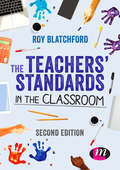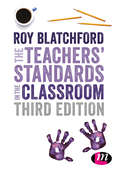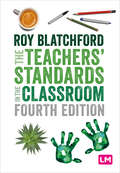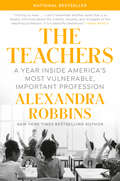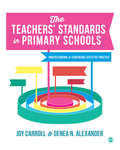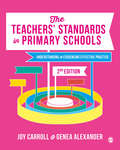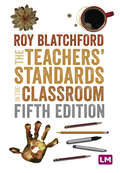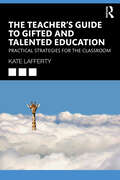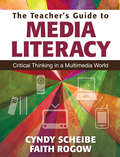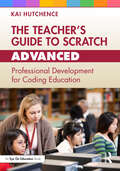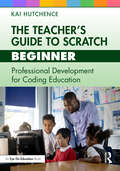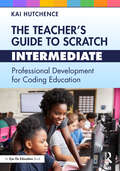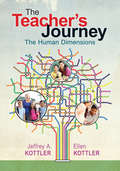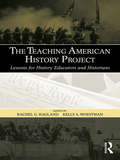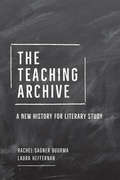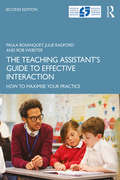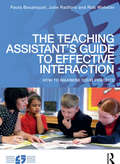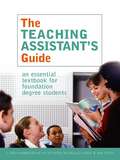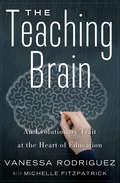- Table View
- List View
The Teachers' Standards in the Classroom
by Roy BlatchfordAll teachers and trainee teachers must work towards and within the framework of the Teachers' Standards. This book is the essential guide to the application of these standards in the classroom. The text supports you to interpret the standards effectively and independently, and to apply them to your teaching. The chapters mirror the standards themselves and practical guidance and classroom-based examples help link theory to practice. The text also enables you to enhance your understanding of the standards and improve your teaching and professional practice. This second edition has been updated to include notes on the new OFSTED framework and the new National Curriculum. Also included are more questions to help trainee teachers think around the standards in relation to placements and assess how and whether they have met the requirements.
The Teachers' Standards in the Classroom (Achieving Qts Ser.)
by Roy BlatchfordAll teachers and trainee teachers need to work towards and within the framework of the Teachers' Standards. This is the essential guide to the application of these standards in the classroom. The text is written to support teachers and trainee teachers to interpret the standards effectively and independently, and to apply them to their teaching. The chapters mirror the standards themselves and practical guidance and classroom based examples help the reader link theory to practice. The text supports readers to enhance their understanding of the standards and to see how their effective application can improve teaching and professional practice. This third edition has been updated to include more classroom stories, links to practice and examples of good practice. Also included is guidance on contemporary issues in relation to the standards, to support teachers with current challenges.
The Teachers' Standards in the Classroom (Ready to Teach)
by Roy BlatchfordAll teachers and trainee teachers need to work towards and within the framework of the Teachers' Standards. This is the essential guide to the application of these standards in the classroom. The text is written to support teachers and trainee teachers to interpret the standards effectively and independently, and to apply them to their teaching. The text supports readers to enhance their understanding of the standards and to see how their effective application can improve teaching and professional practice. This fourth edition has been updated to include checklist for all standards. Also added is guidance on personal and professional conduct online for new teachers. New content on the 2019 Ofsted framework'e expectations of teaching is also added in this edition. About the author Roy Blatchford CBE is Founding Director of the National Education Trust in the UK. He served as one of Her Majesty&’s Inspectors of Schools (HMI) in England, with national responsibilities for school improvement and for the inspection of outstanding schools. Roy was Deputy Chair of the DfE Teachers&’ Standards Review (2012) and of the Headteachers&’ Standards Review (2014). He was appointed CBE for services to education in the 2016 New Year Honours.
The Teachers' Standards in the Classroom (Ready to Teach)
by Roy BlatchfordAll teachers and trainee teachers need to work towards and within the framework of the Teachers' Standards. This is the essential guide to the application of these standards in the classroom. The text is written to support teachers and trainee teachers to interpret the standards effectively and independently, and to apply them to their teaching. The text supports readers to enhance their understanding of the standards and to see how their effective application can improve teaching and professional practice. This fourth edition has been updated to include checklist for all standards. Also added is guidance on personal and professional conduct online for new teachers. New content on the 2019 Ofsted framework'e expectations of teaching is also added in this edition. About the author Roy Blatchford CBE is Founding Director of the National Education Trust in the UK. He served as one of Her Majesty&’s Inspectors of Schools (HMI) in England, with national responsibilities for school improvement and for the inspection of outstanding schools. Roy was Deputy Chair of the DfE Teachers&’ Standards Review (2012) and of the Headteachers&’ Standards Review (2014). He was appointed CBE for services to education in the 2016 New Year Honours.
The Teachers: A Year Inside America's Most Vulnerable, Important Profession
by Alexandra RobbinsA riveting, must-read, year-in-the-life account of three teachers, combined with reporting that reveals what&’s really going on behind school doors, by New York Times bestselling author and education expert Alexandra Robbins. Alexandra Robbins goes behind the scenes to tell the true, sometimes shocking, always inspirational stories of three teachers as they navigate a year in the classroom. She follows Penny, a southern middle school math teacher who grappled with a toxic staff clique at the big school in a small town; Miguel, a special ed teacher in the western United States who fought for his students both as an educator and as an activist; and Rebecca, an East Coast elementary school teacher who struggled to schedule and define a life outside of school. Robbins also interviewed hundreds of other teachers nationwide who share their secrets, dramas, and joys. Interspersed among the teachers&’ stories—a seeming scandal, a fourth-grade whodunit, and teacher confessions—are hard-hitting essays featuring cutting-edge reporting on the biggest issues facing teachers today, such as school violence; outrageous parent behavior; inadequate support, staffing, and resources coupled with unrealistic mounting demands; the &“myth&” of teacher burnout; the COVID-19 pandemic; and ways all of us can help the professionals who are central both to the lives of our children and the heart of our communities.
The Teachers’ Standards in Primary Schools: Understanding and Evidencing Effective Practice
by Joy Carroll Genea N. AlexanderEvery primary school teacher needs to ensure that they meet the criteria set out in the Teachers' Standards. However translating what this means in the classroom isn't always easy, especially when you're starting out your career in teaching. This book directly looks at the standards providing guidance on how professionalism can be demonstrated and evidenced in primary schools underpinned by practical examples. Steps to Success boxes in each chapter look at challenges in the classroom encouraging a reflective perspective on your teaching. Key coverage includes: Effective teaching and learning and what it means to be a learner Planning and assessment for successful teaching Meeting the needs of all children Behaviour management The role of subject and pedagogical knowledge
The Teachers’ Standards in Primary Schools: Understanding and Evidencing Effective Practice
by Joy Carroll Genea N. AlexanderEvery primary school teacher needs to ensure that they meet the criteria set out in the Teachers’ Standards. However translating what this means in the classroom isn’t always easy, especially when you're starting out your career in teaching. This book directly looks at the standards providing guidance on how professionalism can be demonstrated and evidenced in primary schools underpinned by practical examples. Steps to Success boxes in each chapter look at challenges in the classroom encouraging a reflective perspective on your teaching. Key coverage includes: Effective teaching and learning and what it means to be a learner Planning and assessment for successful teaching Meeting the needs of all children Behaviour management The role of subject and pedagogical knowledge
The Teachers’ Standards in Primary Schools: Understanding and Evidencing Effective Practice
by Joy Carroll Genea N. AlexanderEvery primary school teacher needs to ensure that they meet the criteria set out in the Teachers&’ Standards. However translating what this means in the classroom isn&’t always easy, especially when you're starting out. This book directly looks at the standards, providing guidance on how professionalism can be demonstrated and evidenced in primary schools underpinned by practical examples. This second edition introduces two new features: - voices of experience spotlights which explore the perspectives of teachers, parents and other professionals - additional reading and resource suggestions that allow you to find out more about relevant topics. Little light bulb moments and practice examples have been updated to show you how to translate theory into practice, in the classroom and wider learning environments.
The Teachers’ Standards in Primary Schools: Understanding and Evidencing Effective Practice
by Joy Carroll Genea N. AlexanderEvery primary school teacher needs to ensure that they meet the criteria set out in the Teachers&’ Standards. However translating what this means in the classroom isn&’t always easy, especially when you're starting out. This book directly looks at the standards, providing guidance on how professionalism can be demonstrated and evidenced in primary schools underpinned by practical examples. This second edition introduces two new features: - voices of experience spotlights which explore the perspectives of teachers, parents and other professionals - additional reading and resource suggestions that allow you to find out more about relevant topics. Little light bulb moments and practice examples have been updated to show you how to translate theory into practice, in the classroom and wider learning environments.
The Teachers′ Standards in the Classroom (Ready to Teach)
by Roy BlatchfordAll teachers and trainee teachers need to work towards and within the framework of the Teachers′ Standards. This is the essential guide to the application of these standards in the classroom. *Supports teachers and trainee teachers to interpret the standards effectively and independently. *Demontrates how the standards relate to the classroom. *Practical guidance and classroom based examples linking theory to practice. *Enables readers to enhance their understanding of the standards and to see how their effective application can improve teaching and professional practice. This fifth edition edition has been updated to include a visualisation of each standard. Also added is content on the Core Content Framework (CCF) for Initial Teacher Training and the Early Career Framework (ECF).
The Teachers′ Standards in the Classroom (Ready to Teach)
by Roy BlatchfordAll teachers and trainee teachers need to work towards and within the framework of the Teachers′ Standards. This is the essential guide to the application of these standards in the classroom. *Supports teachers and trainee teachers to interpret the standards effectively and independently. *Demontrates how the standards relate to the classroom. *Practical guidance and classroom based examples linking theory to practice. *Enables readers to enhance their understanding of the standards and to see how their effective application can improve teaching and professional practice. This fifth edition edition has been updated to include a visualisation of each standard. Also added is content on the Core Content Framework (CCF) for Initial Teacher Training and the Early Career Framework (ECF).
The Teacher’s Guide to Gifted and Talented Education: Practical Strategies for the Classroom
by Kate LaffertyThe Teacher’s Guide to Gifted and Talented Education: Practical strategies for the Classroom demonstrates ways to build and enhance your understanding of gifted learners with evidence-based, hands-on strategies to use in the classroom. Whether you are looking to improve your own practice or starting out as a Gifted Education coordinator in your school, this book will guide you through each step. Written by an author with extensive practical and research experience in the field, the book is informed by research and covers essential topics from theoretical frameworks to differentiation and innovative pedagogies. Each chapter includes a ‘Back to basics’ section, which provides the key information for those wanting just enough to get going, a ‘Taking it further’ section, which offers a more in-depth critique of the content and a ‘Chapter reflection’ which provides an opportunity to plan and set goals. This book offers a way of thinking about developing the talents of students, at all year levels, in all learning domains and in all contexts. It provides approaches that can be applied in the classroom immediately, or spark bigger conversations within the school. Filled with tips, strategies, checklists and templates, The Teacher’s Guide to Gifted and Talented Education is an essential resource for all educators, from early childhood through to secondary school.
The Teacher’s Guide to Media Literacy: Critical Thinking in a Multimedia World
by Cynthia L. Scheibe Faith RogowUse media literacy to reach all students! This book starts by asking, "What does it mean to be literate in today's world, and how can those literacy skills be developed?" The authors answer those questions by providing concrete, innovative ways to integrate media literacy across the curriculum and teach students to be independent, skilled, and reflective thinkers. Through dozens of suggested activities, teaching strategies, lessons, and a companion Website, the authors’ unique vision allows schools to: Integrate media literacy into teaching at all grade levels and core content areas Address key education standards Teach 21st-century skills and higher-order critical thinking Engage students by bridging schoolwork with their lives outside the classroom
The Teacher’s Guide to Scratch – Advanced: Professional Development for Coding Education
by Kai HutchenceThe Teacher’s Guide to Scratch – Advanced is a practical guide for educators preparing sophisticated coding lessons and assignments in their K–12 classrooms. The world’s largest and most active visual programming platform, Scratch helps today’s schools answer the growing call to realize important learning outcomes using coding and computer science. This book illustrates the expert-level potential of Scratch coding, details effective pedagogical strategies and learner collaborations, and offers actionable, accessible troubleshooting tips. Geared toward the advanced user, these four unique coding projects will provide the technical training that teachers need to master Scratch, feeling comfortable and confident in their skills as they unlock the program’s full potential for themselves and their students. Clear goals, a comprehensive glossary, and other features ensure the project’s enduring relevance as a reference work for computer science education in grade school. Thanks to Scratch’s cost-effective open-source license, suitability for blended and project-based learning, notable lack of privacy or security risks, and consistency in format even amid software and interface updates, this will be an enduring practitioner manual and professional development resource for years to come.
The Teacher’s Guide to Scratch – Beginner: Professional Development for Coding Education
by Kai HutchenceThe Teacher’s Guide to Scratch – Beginner is a practical guide for educators preparing beginners-level coding lessons and assignments in their K–12 classrooms. The world’s largest and most active visual programming platform, Scratch helps today’s schools answer the growing call to realize important learning outcomes using coding and computer science. This book illustrates the benefits and fundamental building blocks of Scratch coding, details effective pedagogical strategies and learner collaborations, and offers actionable, accessible troubleshooting tips. Geared toward the fledgling user, these four unique coding projects will provide the technical training that teachers need to feel comfortable and confident in their skills and to help instill the same feeling of accomplishment in their students. Clear goals, a comprehensive glossary, and other features ensure the project’s enduring relevance as a reference work for computer science education in grade school. Thanks to Scratch’s cost-effective open-source license, suitability for blended and project-based learning, notable lack of privacy or security risks, and consistency in format even amid software and interface updates, this will be an enduring practitioner manual and professional development resource for years to come.
The Teacher’s Guide to Scratch – Intermediate: Professional Development for Coding Education
by Kai HutchenceThe Teacher’s Guide to Scratch – Intermediate is a practical guide for educators preparing moderately complex coding lessons and assignments in their K-12 classrooms. The world’s largest and most active visual programming platform, Scratch helps today’s schools answer the growing call to realize important learning outcomes using coding and computer science. This book illustrates the increasingly intricate affordances of Scratch coding, details effective pedagogical strategies and learner collaborations, and offers actionable, accessible troubleshooting tips. Geared toward the intermediate user, these four unique coding projects will provide the technical training that teachers need to feel comfortable and confident in their skills and to help instill the same feeling of accomplishment in their students. Clear goals, a comprehensive glossary, and other features ensure the project’s enduring relevance as a reference work for computer science education in grade school. Thanks to Scratch’s cost-effective open-source license, suitability for blended and project-based learning, notable lack of privacy or security risks, and consistency in format even amid software and interface updates, this will be an enduring practitioner manual and professional development resource for years to come.
The Teacher’s Journey: The Human Dimensions
by Ellen Kottler Dr Jeffrey A. KottlerMake every day of your teaching count! How many times have you wished your teaching degree came with a handbook? Whether you're a new teacher or a veteran looking for new ideas, best-selling authors Jeffery and Ellen Kottler have crafted a guidebook to navigating the journey ahead. You'll discover how to: Motivate disengaged students through solid interpersonal connection Communicate effectively with parents, counselors, and administrators Advance your professional growth through increased school and district involvement Understand your teaching self more deeply through reflection Build a culture of tolerance and respect in the classroom
The Teaching American History Project: Lessons for History Educators and Historians
by Rachel G. Ragland Kelly A. WoestmanThe premise of the Teaching American History (TAH) project—a discretionary grant program funded under the U.S. Department of Education’s Elementary and Secondary Education Act— is that in order to teach history better, teachers need to know more history. Unique among professional development programs in emphasizing specific content to be taught over a particular pedagogical approach, TAH grants assist schools in implementing scientifically-based research methods for improving the quality of instruction, professional development, and teacher education in American history. Illustrating the diversity of these programs as they have been implemented in local education agencies throughout the nation, this collection of essays and research reports from TAH participants provides models for historians, teachers, teacher educators, and others interested in the teaching and learning of American History, and presents examples of lessons learned from a cross-section of TAH projects. Each chapter presents a narrative of innovation, documenting collaboration between classroom, community, and the academy that gives immediate and obvious relevance to the teaching and learning process of American history. By sharing these narratives, this book expands the impact of emerging practices from individual TAH projects to reach a larger audience across the nation.
The Teaching Archive: A New History for Literary Study
by Laura Heffernan Rachel Sagner BuurmaThe Teaching Archive shows us a series of major literary thinkers in a place we seldom remember them inhabiting: the classroom. Rachel Sagner Buurma and Laura Heffernan open up “the teaching archive”—the syllabuses, course descriptions, lecture notes, and class assignments—of critics and scholars including T. S. Eliot, Caroline Spurgeon, I. A. Richards, Edith Rickert, J. Saunders Redding, Edmund Wilson, Cleanth Brooks, Josephine Miles, and Simon J. Ortiz. This new history of English rewrites what we know about the discipline by showing how students helped write foundational works of literary criticism and how English classes at community colleges and HBCUs pioneered the reading methods and expanded canons that came only belatedly to the Ivy League. It reminds us that research and teaching, which institutions often imagine as separate, have always been intertwined in practice. In a contemporary moment of humanities defunding, the casualization of teaching, and the privatization of pedagogy, The Teaching Archive offers a more accurate view of the work we have done in the past and must continue to do in the future.
The Teaching Archive: A New History for Literary Study
by Laura Heffernan Rachel Sagner BuurmaThe Teaching Archive shows us a series of major literary thinkers in a place we seldom remember them inhabiting: the classroom. Rachel Sagner Buurma and Laura Heffernan open up “the teaching archive”—the syllabuses, course descriptions, lecture notes, and class assignments—of critics and scholars including T. S. Eliot, Caroline Spurgeon, I. A. Richards, Edith Rickert, J. Saunders Redding, Edmund Wilson, Cleanth Brooks, Josephine Miles, and Simon J. Ortiz. This new history of English rewrites what we know about the discipline by showing how students helped write foundational works of literary criticism and how English classes at community colleges and HBCUs pioneered the reading methods and expanded canons that came only belatedly to the Ivy League. It reminds us that research and teaching, which institutions often imagine as separate, have always been intertwined in practice. In a contemporary moment of humanities defunding, the casualization of teaching, and the privatization of pedagogy, The Teaching Archive offers a more accurate view of the work we have done in the past and must continue to do in the future.
The Teaching Archive: A New History for Literary Study
by Laura Heffernan Rachel Sagner BuurmaThe Teaching Archive shows us a series of major literary thinkers in a place we seldom remember them inhabiting: the classroom. Rachel Sagner Buurma and Laura Heffernan open up “the teaching archive”—the syllabuses, course descriptions, lecture notes, and class assignments—of critics and scholars including T. S. Eliot, Caroline Spurgeon, I. A. Richards, Edith Rickert, J. Saunders Redding, Edmund Wilson, Cleanth Brooks, Josephine Miles, and Simon J. Ortiz. This new history of English rewrites what we know about the discipline by showing how students helped write foundational works of literary criticism and how English classes at community colleges and HBCUs pioneered the reading methods and expanded canons that came only belatedly to the Ivy League. It reminds us that research and teaching, which institutions often imagine as separate, have always been intertwined in practice. In a contemporary moment of humanities defunding, the casualization of teaching, and the privatization of pedagogy, The Teaching Archive offers a more accurate view of the work we have done in the past and must continue to do in the future.
The Teaching Assistant's Guide to Effective Interaction: How to Maximise Your Practice
by Rob Webster Paula Bosanquet Julie RadfordThis second edition of The Teaching Assistant’s Guide to Effective Interaction is the definitive guide to teaching assistant-pupil interaction, fully updated with examples from schools that have implemented techniques from the first edition. An invaluable professional development tool for classroom support staff and the teachers who work with them, this new edition answers the need for specific, practical guidance on the role of the teaching assistant. This practical and accessible guide sets out a role for teaching assistants that focuses on developing pupils’ independence and ownership of learning, with key learning points now summarised in each chapter. Based on a classroom-tested framework and covering the main contexts in which teaching assistants work, it includes a range of strategies and reflective activities to help improve the support provided to pupils in everyday settings. This book sets out successful strategies for: Responding to additional needs Understanding the principles behind effective classroom talk Carefully scaffolding pupils’ learning Delivering intervention programmes The Teaching Assistant’s Guide to Effective Interaction is an essential read for all teaching assistants and will also be of interest to school leaders, SENCOs and teachers in both primary and secondary schools who wish to improve their deployment of teaching assistants and their own interactions with pupils. Used in combination with Maximising the Impact of Teaching Assistants in Primary Schools, The Teaching Assistant’s Guide to Effective Interaction is a comprehensive and unrivalled resource for supporting school workforce improvement.
The Teaching Assistant's Guide to Effective Interaction: How to maximise your practice
by Rob Webster Paula Bosanquet Julie RadfordThe Teaching Assistant’s Guide to Effective Interaction is the definitive guide to teaching assistant-pupil interaction and an invaluable professional development tool for classroom support staff and the teachers who work with them. The authors’ research and development work with schools has highlighted the need for specific, practical guidance on the role of the teaching assistant. This highly practical and accessible book sets out a role for teaching assistants that focuses on developing pupils’ independence and ownership of learning. Based on a classroom-tested framework, and covering the main contexts in which teaching assistants work, it includes practical strategies and reflective activities to help you improve the support you provide to pupils in everyday settings. This book will help you to: Improve your interactions with pupils Understand the principles behind effective classroom talk Carefully scaffold pupils’ learning Work effectively in collaboration with teachers Support the Assessment for Learning process Support group work and collaborative tasks Deliver intervention programmes. This book is an essential read for all teaching assistants. It will also be of interest to school leaders, SENCos and teachers, in both primary and secondary schools, who wish to improve their use of teaching assistants and their own interactions with pupils.
The Teaching Assistant's Guide: New perspectives for changing times
by Michelle Lowe Jim Pugh Linda Hammersley-FletcherThis textbook, designed to meet the needs of students on the teaching assistant foundation degree, provides an accessible overview of the teaching assistant's role, incorporating practical tasks that will challenge students to reflect on and improve their day-to-day practice. Set within a wider educational context, and full of thoroughly grounded advice throughout, this book includes: personal professional development - helping teaching assistants to understand their role and their workplace growth, development and learning - introducing the basic theories human development and learning behaviour management - exploring strategies that encourage and support appropriate behaviour today's curriculum and how children learn literacy, maths, science and technology understanding inclusive education, exploring access, participation and additional needs for specific groups of young people. With activities, task lists, discussion points, ideas, summary points and notes on further reading, this textbook will be the essential companion for all foundation degree students, as well as a useful handbook for teaching assistants in practice.
The Teaching Brain: An Evolutionary Trait at the Heart of Education
by Vanessa Rodriguez Michelle Fitzpatrick&“A significant contribution to understanding the interaction among teachers, students, the environment, and the content of learning&” (Herbert Kohl, education advocate and author). What is at work in the mind of a five-year-old explaining the game of tag to a new friend? What is going on in the head of a thirty-five-year-old parent showing a first-grader how to button a coat? And what exactly is happening in the brain of a sixty-five-year-old professor discussing statistics with a room full of graduate students? While research about the nature and science of learning abounds, shockingly few insights into how and why humans teach have emerged—until now. Countering the dated yet widely held presumption that teaching is simply the transfer of knowledge from one person to another, The Teaching Brain weaves together scientific research and real-life examples to show that teaching is a dynamic interaction and an evolutionary cognitive skill that develops from birth to adulthood. With engaging, accessible prose, Harvard researcher Vanessa Rodriguez reveals what it actually takes to become an expert teacher. At a time when all sides of the teaching debate tirelessly seek to define good teaching—or even how to build a better teacher—The Teaching Brain upends the misguided premises for how we measure the success of teachers. &“A thoughtful analysis of current educational paradigms . . . Rodriguez&’s case for altering pedagogy to match the fluctuating dynamic forces in the classroom is both convincing and steeped in common sense.&” —Publishers Weekly
